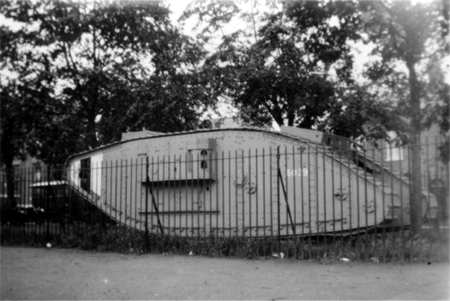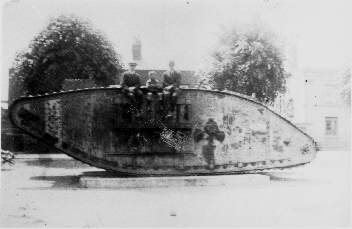The 'Female' Tank at Bachelor's
Acre
1920 - 1940

Photographed in 1935 by
Mr C P Davies (age 14), this First World War tank was a feature
in Bachelor's Acre for 20 years.
The tank was
supplied to Windsor complete with its engine on 29th May 1920,
arriving by train at the GWR goods yard (now the coach park)
and then driven at a brisk walking pace, and attracting much
attention, along Goswell Road, Arthur Road, Alma Road and Clarence
Road, to Victoria Street and Bachelors Acre where it was officially
handed over to the Mayor, Mr W Fairbank, by Sir Victor Mackenzie,
DSO, MVO, 1st Scots Guards in recognition of the aid, some £1.3
million, raised by the people of Windsor towards the expenses
of the 1914-18 war.
The tank's petrol engine, rather than 'oil', was
at some later date sold to a 'Mr Farrow of the Electric Light
Works in Peascod Street at a low price'. After some correspondence
in the local paper the engine was returned to the tank but "dumped
on the chassis, not bolted down."
According to the Tank Museum at Bovington, the tank
is a female, (armed with machine guns in barbettes at each side),
Mk. IV, no. 6039, and saw service in France, possibly in the
battle of Bourlon Wood between Arras and Cambrai, in November
1917. The tank had suffered battle damage in the form of bullet
holes as well as two 'missiles' embedded in it.
In the photograph above three stripes are clearly
visible at the front. These were coloured white - red - white
and distinguished British tanks from those captured by the Germans
and used against the Allies.
Approximately 1200 of these MK IV tanks, weighing
some 27 tons each, were made between 1916 and 1919 of a total
of around 2000 tanks in all. A description of the tank's arrival
in Windsor is included in the Windsor Express of 5th June 1920.
Another item of first world war surplus armament
was the field gun located in Alexandra
Gardens but both
the tank and field gun were removed in February 1940. Mr F N
Macrae, Borough Engineer at that time, had the metal of the tank
tested and it was found to be made of valuable gun-metal (an
alloy of copper and tin) and not of iron as originally thought.
At the start of WWII there was a considerable effort nationwide
to collect together as much scrap metal as possible for the war
effort but it is possible that Windsor's tank, field gun, and
many railings, fences and gates, some very ornate, were lost
when the ship carrying them was bombed and sunk in the Thames
Estuary. The slab upon which the tank had stood was shortly thereafter
used as the foundation for an Air Raid shelter.

An earlier view of the
tank before the railings were erected to reduce vandalism. This
photo supplied by Mr John Maxwell, of Oakley Green, taken by
his brother in the early twenties.
In 2008 we were
delighted to receive the following story from JW:
The tank's delivery
crew stayed at The Bull in Peascod Street. My mother, at the
age of 9, and in what started out as a spotless summer dress,
was allowed to ride inside the tank as it was driven around Windsor
before being driven onto its concrete base and deactivated.
According to
my Aunt Mercia, who had charge of her younger sister that day,
'the inside of the tank was filthy and so was Mum's dress when
she got out at the other end of the ride.' Aunt Mercia said Grandma
Maud was furious that she had allowed Mum to get so dirty, "Nice
gels don't get dirty!" she said!
When Mother
died, amongst her papers I found a 'Bull Hotel' menu card autographed
by all of the delivery crew and annotated with 'Jos Wilson' who
rode in our tank around Windsor and the date. I sent a copy to
the Bovington Tank Museum - who hadn't known up to that point
that Windsor had been one of the towns to be given a tank under
the scheme.
More details
of the Bachelor's Acre tank appears in
Windlesora No 13 published by the Windsor Local History Group.
The
Tank Museum, Bovington
Back
to History Home Page
Back
to Windsor Home Page

To contact
us, email Thamesweb
|



